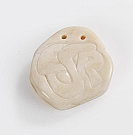
Nam June Paik
1932 Seoul
2006 Miami
Nam June Paik and his family went to Hong Kong and then on to Japan to escape the Korean War. In 1956 Paik graduated from the university of Tokyo, where he had studied Music, History of Art and Philosophy, having written a thesis on Arnold Schönberg. The artist then continued his studies of art history at the university of Munich and studied composition under Wolfgang Fortner at the "Musikhochschule Freiburg". In 1957 Paik took part in the "Internationaler Sommerkurs für Neue Musik" in Darmstadt, where he met Karlheinz Stockhausen and John Cage.
Nam June Paik was fascinated by the technique of breaking up traditional musical structures by including noise, quietness, gestures, mimic, coincidence and everyday things. With the "TV-works" he produced from 1963, in which he dealt with the allocation of television sets in space and their manipulation, multiplication and functionless nature, the artist showed a new dimension of openness. In 1964 Nam June Paik moved from Tokyo to New York, where he developed a longterm cooperation with cellist Charlotte Moormann. In the subsequent years Nam June Paik, as the main exponent of the Fluxus movement, staged numerous events inspired by John Cage, in which Paik geve the central role to music.
At the same time the artist created the first robot and video installations, which were characterized by a connection between music and the electronic generation of images. The large video environment shown at the Kassel "documenta VI" marked the peak of his video art.
Since 1979 the artist has been a professor at the "Staatliche Kunstakademie" in Düsseldorf, Germany. Hence Paik increasingly included floors, ceilings and walls in some of his installations. The so-called "Family of Robot", humanoid figures assembled from TV-sets, radios etc. were created from 1986 onward. The artist continued to produce these in series.
In 1988 Nam June Paik set up "The more the better", a media tower consisting of 1003 screens, showing the programms of television stations from 12 different countries at the Seoul Olympic Games. Five years later the artist exhibited his videos in the German pavilion of the Venice Biennale and received the Kyoto Prize in 1998.
Nam June Paik died at the age of 73 in Miami, FL.
Related artists: Alfano, Carlo | Antes, Horst | Arman, Fernandez | Beuys, Joseph | Boetti, Alighiero E. | Bonalumi, Agostino | Brodwolf, Jürgen | Calderara, Antonio | César, (d.i. César Baldaccini) | Christo | Droese, Felix | Fontana, Lucio | Förg, Günther | Geiger, Rupprecht | Girke, Raimund | Graubner, Gotthard | Götz, Karl Otto | Hansen, Al (Alfred Earl) | Hauser, Erich | Hirst, Damien | Hoehme, Gerhard | Horn, Rebecca | Kiefer, Anselm | Kippenberger, Martin | Knoebel, Imi | Kolár, Jirí | Kricke, Norbert | Lakner, László | Luther, Adolf | Manzoni, Piero | Merz, Gerhard | Merz, Mario | Nauman, Bruce | Nitsch, Hermann | Paladino, Mimmo | Palermo, Blinky | Paolozzi, Eduardo | Pfahler, Georg Karl | Polke, Sigmar | Rainer, Arnulf | Richter, Gerhard | Roth, Dieter | Rückriem, Ulrich | Schumacher, Emil | Scully, Sean | Sonderborg, K.R.H. (d.i. Kurt R. Hoffmann) | Spoerri, Daniel | Stella, Frank | Tinguely, Jean | Tobey, Mark | Twombly, Cy | Uecker, Günther | Vautier, Ben | Vostell, Wolf | West, Franz

Would you like to sell a work by Nam June Paik?
Infos for sellerART MARKET:
No items found for this artist.






